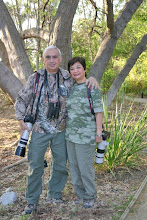The most common species we encountered was the Red-winged Blackbird, the males of which were constantly bursting in song at almost every bush and tree along the trails.
Then Cynthia spotted a flash of brilliant red - the gorget of an Allen's Hummingbird resplendent in the sun.
Further on we encountered a birder couple and when asked the customary "anything interesting?" they replied that there were Bullock's Orioles about 50 feet from where we were. Thus began our quest for the gorgeous yellow and black bird. These species prefer the higher branches of tall trees and very seldom fully shows itself to observers (and photographers) like us. Their chittering calls made them easy to locate - but viewing them and getting a good enough picture is another story. On a few occasions while searching for the orioles up on the treetops, we would encounter an unexpected and relatively quieter bird in the same tree.
Like a Spotted Towhee
and a Blue Grosbeak.
The California Towhee is one of the friendliest birds in Southern California, often hunting for food just a few feet away, oblivious of any passing people.
It was getting quite hot at around 11 am and we already had our share of oriole pictures -mostly half-bodied and peering out of a bunch of leaves. So we decided to call it a day. "I wish we had better shots of the oriole", Cynthia sighed, "they are just so colorful!"
On the way to the parking area, I saw a sparrow that looked a bit different - so far we have seen the very common House and Song Sparrows - and I was so happy to discover that it was a Chipping Sparrow. That was the fist time we've seen this species here.
When we reached the Jeep, I packed my gear in my knapsack and then inserted the key in the ignition. As I was about to turn it on, I saw a flash of yellow alit on an iron structure right in front of us. "Oriole!" we yelled simultaneously. "Shoot! Shoot!" I ordered my wife who was still cradling her camera gear on her lap. "Here, you have a better view", she said handling her 30D+300mm combo to me.
It was divine intervention we both agreed.










.jpg)
.jpg)



.jpg)














.jpg)










